A paradigm shift for early childhood mathematics?
Maulfry Worthington, Vrije Universiteit, Amsterdam
An important aspect of mathematics in primary school is the need for children to use its abstract written symbols. However, research has shown that using standard mathematical signs is challenging for young children, the mathematics they copy or colour-in often failing to make personal sense. Yet this important aspect of mathematics education has been largely misunderstood and its significance undervalued in schools and by policy makers and curriculum writers.
Vygotsky identified the benefits of social learning contexts in which children can draw on their existing cultural knowledge. This article explores the graphical signs and texts of three young nursery school children as they spontaneously communicated their mathematical thinking within their pretend play. The findings show the extent to which they explored diverse aspects of mathematics, learner-agency playing a significant role in their personal understandings, and dependent on the democratic values of the school.
Free pretend play contexts enable children to make connections with their existing home cultural knowledge and understandings. Analysis shows that learner-agency empowers children to make individual decisions and choices, to self-initiate their play, the mathematics that arises within it, and greater fluency and flexibility of sign-use, deepening understanding and highlighting the power and potential of impromptu pretend play.
Introduction
What can children’s free and spontaneous pretend play reveal about their thinking, understandings and mathematical notations? The following play episode provides one example:
Moving a small cupboard to create a security safe, four-year old Isaac placed a keyboard and clipboard on top. Together with his friend Jayden, they transported wooden blocks on a trolley, and when another child removed one, Jayden wrote wavy lines on his clipboard. Then placing his paper in their ‘safe’, tapped several keys on the keyboard, repeating this each time a child removed a block. Isaac announced: ‘this is the safe. There’s a key, only one - you press it here and it opens. It has a number and no one else knows it, “one, one, eight, seven, zero, six.” It’s rather difficult to remember.’
Jayden put some real coins and play cheques in their safe and Isaac stuck a calculator on the cupboard door adding, ‘you need to press the buttons to get in the safe […] it’s “four, nine, seven, nine.”’ He pressed some numbers making, ‘beep, beep’ noises as he opened it, then closing the doors asked, ‘what’s the closing number?’ saying, ‘one, nine, five, two’ again pressing the calculator’s buttons.
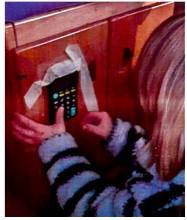
Later Jayden told their teacher Emma, ‘you need to give me “one, nine, five, two’, and Emma explained that she didn’t have enough cash but could write a cheque. Isaac replied, ‘I need hundreds of pounds!’ Emma found a selection of coins in her purse and Jayden responded, ‘okay! We need to fill the box: you need to give me £1,500.60.’ After several days’ playing with their ‘safe’, Isaac decided to write down the number of blocks being taken, and making some scribble-marks announced, ‘one, two, three, gone! Gotta write it down and put it in the safe.’
Isaac’s interest in technologies, security and money were evident in this and in many of his other play narratives. Appreciating Isaac’s interests, his teacher had previously brought in a small safe for the children to investigate. Mathematics arose naturally within their play, making it personally meaningful: this stimulated excitement and high levels of involvement, resulting in rich play that held the boys’ interest over several days.
Recent research
This article provides an overview of recent doctoral research into young children’s personal mathematical notations made in self-initiated spontaneous pretend play. Drawing on our previous research (e.g., Carruthers & Worthington, 2005; 2006; 2011), it aims to identify influences from the children’s home cultural knowledge on their emergent understandings. The research established the evolution of young children’s marks and signs, made in contexts that can be understood as mathematical.
My doctoral research (Worthington, 2021) investigated the emergence and development of 3-4-year-old children’s personal mathematical signs in a nursery school in a large, ethnically diverse city in the south-west of England. The emphasis in this nursery school is on its democratic values and beliefs which are shared by all the staff and guide their approaches and pedagogical practices. Case-studies of seven children provided data consisting of the children’s own graphical signs and texts (drawing, writing and mathematical), combined with teachers’ documented observations of the children’s pretend play. The teachers were asked to identify three children who had often chosen to write or draw in the previous school year (as focal children), in order to discover if their interest continued: it was expected that this would also allow comparison with the findings of the other four children. Examples of play and graphics of three of the children are included in this article. At the start of my research Isaac (whose family origins are in England) and Shereen were both 4 years of age, and Shereen’s family was from the Philippines: (Isaac and Shereen were focal children). Tiyanni was 3 years and 5 months of age, and her family came from the West Indies.
Early childhood mathematics
It is widely recognised that the formal representations of mathematical abstraction are challenging for children, yet much teaching is devoted to showing children how to write numerals 0-9, and operators such as ‘+’ and ‘-’. Children may be required to colour-in and complete worksheets or something their teacher has drawn or written. In traditional approaches, children’s learning is often individualistic, in which they are largely passive recipients of the mathematics provided by the teacher.
This subject-centred learning is one in which mandatory curriculum documents, learning goals, taught mathematical skills and teacher-planned mathematical tasks are the basis for mathematical activities: neither the children’s personal understandings nor their own mathematical signs feature in this approach. Children are expected to use and remember standard symbols that lack any meaningful contexts or have personal sense. Children’s difficulties can cause increasing confusion, a growing dislike of mathematics, a lack of confidence and alienation from mathematics (e.g., Radford, 2016; Van Oers, 2012) that only increases when they are introduced to calculations, problem-solving and other aspects of representing mathematics in school (Nunes, 1993; Ernest, 2005). As Van Oers (2001) emphasises, most mathematics children meet in school depends on written symbols. This presents a challenge for teachers of young children, in how they might support them in contexts that are in harmony with young children’s interests and development.
In 1986 the English psychologist Martin Hughes concluded from his seminal research that before starting school, children have considerable ability with numbers, but that they seem to lack understanding of the standard written language of mathematics, including how to use symbols. Hughes (p. 170) emphasised that children need to “bridge the gap” between children’s concrete, practical understandings and their use of standard numerals, recommending that teachers “build on children’s own strategies” and “respect their invented symbolism” (p. 176/177, emphasis in the original). He acknowledged “the immense capacity of young children to grasp difficult ideas if they are presented in ways which interest them and make sense to them” (p. 184). The difficulties that young children face is that traditionally taught, the mathematics they meet often fails to make personal sense.
Pretend play
Globally, the common practice in early childhood education is for teachers to plan, set up and resource a pretend play area, often planned with particular expectations in mind - such as a Post Office - in which children can weigh parcels and use money. This practice, common in most of the world is highlighted by Worthington and Van Oers (2016), it reveals:
adults’ perceptions of children’s interests, rather than children’s authentic and immediate interests that have personal cultural meaning. In contrast when children initiate and freely shape their play, their authentic and immediate interests have personal cultural meaning. (p. 52, emphasis in the original)
According to Fleer (2010), play that is planned and owned by teachers ‘may result in concepts that are conceptually disembedded from the practices and the imaginary situation being played out by the children’ (p. 75, italics in the original). For Vygotsky (1978, p. 102-103) pretend play is the ‘leading activity’ and ‘a major source of development’ for young children, offering potentially rich contexts that situate learning, allowing them to explore their existing cultural knowledge of mathematics. However, Gifford (2005, p. 2) pointed to a number of research studies (including her own), in which virtually no evidence had been found of children freely referring to aspects of mathematics in their pretence.
Unlike most nursery and primary schools, teachers in this nursery school do not plan or set up specific pretend play areas. The children are free to spontaneously self-initiate the focus and location of their play, choosing the friends with whom to play and the resources they want to use. The children lead and guide the development of their play, staying close to their cultural focus and interest. My findings showed that, in contrast to Gifford’s observations, during the year the children often freely explored many aspects of mathematics in their pretend play, including:
· Number, quantities and counting
· Money
· Time
· Length and distance
· Direction
· Speed
· Weight
· Temperature
· Shape, space and capacity
· Data handling
Why should these findings be in such sharp contrast with those of previous studies? It appears that since the philosophy and culture of this nursery school are democratic, the children feel empowered to make personal meanings connected to their previous knowledge and understandings. Importantly this allows children to have agency, children feeling that they can make genuine choices and decisions that make personal sense. However, in order to do so, teachers too need agency (Carruthers, 2021), and freedom to be open to the possibilities of pretend play for mathematics.
Funds of Knowledge
Vygotsky (1987) highlighted dual means of developing cultural knowledge, first, through children’s home experiences, and second in pretend play. He argued that pretend play supports spontaneous or everyday (i.e., informal) concepts, establishing foundations for the subsequent formation of increasingly scientific (i.e., formal, school) concepts (p. 220/238).
Research into children’s ‘funds of knowledge’ (e.g., Moll et al., 1992) considers how children’s informal knowledge of family practices enriches their cultural knowledge: it also intensifies their mathematical understandings (Worthington, 2018). The findings of my research showed that every one of the children’s play episodes was influenced by their personal ‘funds of knowledge’, understandings founded in their experiences at home and in their communities.
Examples of three of the children’s home cultural knowledge and their related play themes are shown in the table in figure 2.
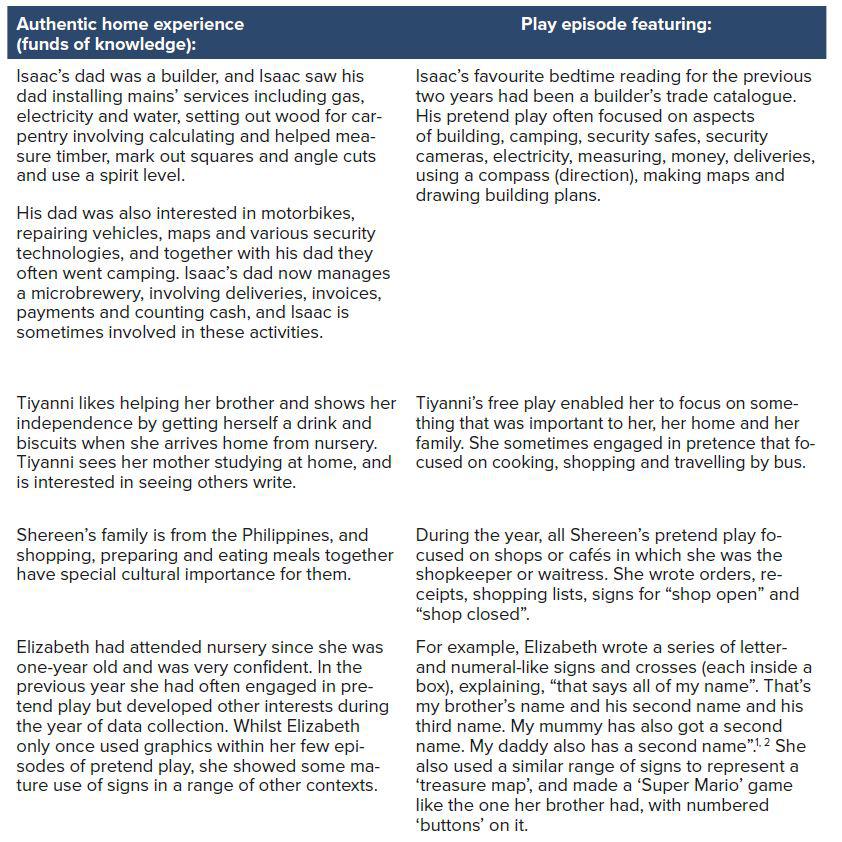
Using signs and symbols to draw and write
Young children’s graphical signs originate in the marks they make in their early drawings (Lancaster, 2014; Worthington, 2009). At first it is difficult for them to differentiate symbols for writing and those for mathematics, but it is important that they understand the purpose of their signs. For Vygotsky (1978, p. 118, emphasis added), ‘writing should be meaningful for children, that an intrinsic need should be aroused in them, and that writing should be incorporated into a task that is necessary and relevant for life’. I expected to identify instances when the children also spontaneously chose to write within their play and found evidence of multimodality, the children using a variety of materials, and a wide range of marks and signs, their choices and textual means of representing mathematics very similar to that for writing. For example, the children used different tools and surfaces to communicate through graphics, some using the sand outside to make written signs as letters: others used paper, a sheet of plastic, old diaries, clipboards or child-height whiteboards.
Graphicacy
Our previous research showed that children already have considerable understanding of writing and mathematical signs before they are taught (see also Tolchinsky, 2003), and can use their emergent understandings to represent and communicate their thinking. Sometimes referred to as notations, inscriptions or symbolic tools, graphical signs encompass all their early marks and signs including scribble-marks, drawings, their personal maps, early writing and those they use to express their mathematical ideas. The children’s developing understanding of signs for mathematics arises from their frequent sign-use to which they attach meanings.
Children’s Mathematical Graphics, (a term originated by Carruthers and Worthington) is a holistic approach that views children as emergent learners in which their mathematical thinking, talk and graphics are seen within the context of all the children’s social and collaborative meaning-making and learning. Teachers understand that young children learn best within social contexts in which young children have considerable agency and are active learners. The child is at the centre and develops spontaneous concepts through ample freedom to explore, supported by, and in collaboration with peers and adults.
The most significant aspect of this open approach is that the signs the children choose to use are freely made with understanding, rather than because a teacher has asked them to copy something, or told them what to write. Moreover, the children’s early signs provide the foundations for deepening understandings of the increasingly abstract written mathematics they will meet in school.
My doctoral research identified three particular aspects of young Children’s Mathematical Graphics:
Communication through early marks: to communicate their thinking, children use their early explorations with marks, to which they attach mathematical meanings. These early marks include scribble-marks (intentionally made), and many dots to represent large quantities. Children sometimes use scribble-marks when playing, as ‘shorthand’ for something they wish to express, allowing them to continue their play without interruption. They will often accompany their marks orally, but without the child’s explanation, young children’s earliest marks are not always easy for the adult to understand, although constitute an important aspect of their developing understanding.
Increasing formalisations: children’s growing use of iconic signs help bridge the gap in their understanding. Resembling standard symbols, these include tallies, wavy or zigzag lines (suggesting writing), occasional drawings, letter-and numeral-like signs, crosses, ticks and arrows, these signs transforming gradually into standard symbols, including those that are mathematical.
Formal mathematical symbols: through freely imitating signs and symbols that their teacher models and emulating those made by others, children’s signs are transformed into the formal written symbols of the abstract cultural language of mathematics.
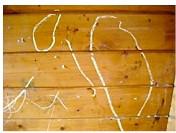
Tiyanni and some friends went into the gazebo in the garden, Tiyanni announcing ‘it’s our house’. Her teacher asked if it had a number and Tiyanni responded by writing numbers on the wall in chalk, explaining: ‘That’s the number 8’ (pointing to the almost enclosed circle on the right of the photo), ‘and the other number’s “9”.’ Drawing on the work of Cassirer (1923), increasing abstraction shows that situations are viewed from a personal point of view, evident in a group or class when there can be many different graphical interpretations of the same aspect of a mathematical situation. In contrast the answers on a worksheet are likely to all be the same.
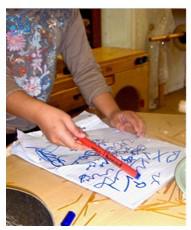
Taking orders in her pretend café, Shereen drew on her personal (cultural) and social knowledge ofcafés. She used scribble-marks, wavy, writing-like lines, and a drawing ofa fish and a mushroom. After a while she asked her teacher Emma, ‘what youwant: rice, chocolate, cake, chicken?’ Emma said she didn’t wantchicken and Shereen wrote writing-like marks for ‘chicken’ with a cross by it, clarifying, ‘It says “x” - no chicken.’ Later Emma asked again for chicken, but pointing to the ‘x’ she had written,Shereen reminded her, ‘Look! No chicken! You want mushroom?’ Thenpointing to her drawing of a mushroom explained, ‘Look. A tick,thatmeanwegotsome.’ Shereen’s cross and tick have particular power concerning quantities and the availability of chicken and mushrooms.
Mathematical literacy
Munn (1994, p. 13) argued that the functional use of signs for mathematics is ‘essentially a literate strategy’, a conviction shared by others (e.g., Pupura & Napoli, 2015; Carruthers & Worthington, 2006). My findings showed that the extent to which parents engaged in literacy practices (sometimes with their child) for real purposes, impacted the child’s cultural knowledge of literacies and were mirrored in the nursery: for example, linking with his father’s interest in old maps, Isaac often drew maps in the nursery. The children frequently self-initiated literacy events and their cultural knowledge considerably enriched their understandings, revealing different genres including persuasive letters, bookings for a campsite, receipts and writing letters to someone. The children appeared to feel a need to communicate their thinking through their various signs in their own ways, rather than their mathematical literacy being directly imposed.
Teachers
In practical terms, the teachers in this nursery school prepared the environment, providing diverse resources, including a range of surfaces for the children’s notations (e.g., papers, whiteboards and old diaries) and writing tools such as pencils, coloured pens and chalk. Number lines indoors and out are also an important resource, with numbers up to 100, 1,000, negative number lines, and some written in the home languages of children in the nursery. Added to these, numerals are presented in realistic contexts, and children’s graphical texts (drawings, maps, writing and mathematical) are displayed on the walls.
The classroom and outdoor area in this nursery include resources that the children may use without asking, and some decide to move furniture without asking, as Isaac and Jayden had done. Most significantly it is the children who lead their play, rather than adults. Teachers value the children’s ideas, sometimes participating in the play with understanding, without dominating it or imposing expectations of particular aspects of mathematics. They support the children’s dialogue, have high esteem for the children’s thinking and representations, and look for opportunities to provide subsequent support for children’s ideas that arise in their play. Teachers recognise the significance of modelling signs and symbols each day, embedding signs and texts in contexts that have genuine and personal meaning for the children, and do not expect the children to immediately follow these notations by copying what the teacher has done.
The teachers also plan designated small groups with a distinct mathematical focus (such as bringing in several bathroom scales for the children to explore), with paper and child-height whiteboards to hand. In these groups it is the children once again who take the lead, communicating through dialogue and their own graphical signs and texts.
Lexicons
Children’s signs and symbols develop as communicative tools, and by three - four years of age most have developed an evolving sign-lexicon or repertoire. This expansion of graphical lexicons is beneficial, enabling them “to select what is for them, the most appropriate sign from one context, to ‘fit’ in another, and for a particular communicative purpose” (Worthington, 2020, p. 70). Papandreou (2019, p. 3) observes that encouraging children to use and consider their inscriptions “may increasingly contribute to an emerging metaknowledge about inscriptions.”
However, fluency and flexibility in sign-use are unlikely to be achieved in traditional, transmission teaching contexts, suggesting constraints on children’s capacity to communicate through signs with fluency that is likely to impact their confidence and consequent success with mathematics. If children are only given the signs and symbols of mathematics, they will adopt only superficial features, “unable to transform them into a personally meaningful system” (Ernest, 2005, p. 25). In my research I also found that those with the most extensive sign-repertoires frequently engaged in drawing at home. These same children used writing-like zigzag or wavy lines; wrote their names most frequently and used the greatest quantity of standard letters (both upper and lower-case) and standard numerals (Worthington, 2020, p. 79). The findings of this research show that children differ in their cultural experiences of home, especially relating to seeing and participating in adults’ use of graphical signs to convey meaning, and in authentic experiences and talk involving mathematics.
Added to these differences, in the nursery young children exhibit different play interests, some seldom engaging in pretend play. Nonetheless, children in this nursery school who choose different play contexts (rather than pretence) have many other opportunities to communicate freely through graphicacy, including ‘open’ group contexts, and some of these will focus on aspects of mathematics, such as using bathroom scales to weigh themselves.
Those who frequently and freely participate in pretence, appeared to be at an advantage, since, according to the full findings of this full research (Worthington, 2021), they chose to draw on their cultural knowledge, significantly often also spontaneously communicating through writing and inscriptions to convey their mathematical thinking. These findings suggest that above all, those children who had developed the most extensive sign-lexicons, were also those who spontaneously wrote standard Arabic number symbols (Worthington, 2021).
Provided that teachers have a good understanding of the importance and value of children’s free pretend play, and of young children’s graphical signs to make and communicate meanings, children will be likely to develop increasingly rich repertoires of signs.
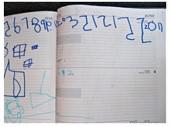
Elizabeth sat next to Cameron in the gazebo, both with large diaries. Writing standard number symbols across the top of both pages (some of the numerals reversed), Elizabeth
read pairs of numerals as “teen” numbers, (reading from the left-hand page and across the right) as ‘13, 12, and 15’.
Spontaneous focusing on numerosity (SFON) (i.e., focusing on standard Arabic number symbols), has been identified as indicative of future success in school: for example, Pupura & Napoli (2015) compared preschoolers’ informal knowledge of numerals, emphasising that understanding appears to depend considerably on literacy-related skills. Two-digit numbers are challenging for children, but the findings of my research suggest a direct relationship between the extent of children’s graphical repertoires and spontaneously writing Arabic numerals or ‘SWANS’ 1 , a finding that extends beyond previously cited research.
Reflections
This research demonstrates the power and potential of children’s free pretend play, showing how it underpins their natural and meaningful beginnings with the ‘written’ language of mathematics. This is not teaching using play to fit curriculum goals, but play that belongs to children and is open to their cultural knowledge and interests.
Young children know intuitively what ‘real’ play is, taking delight in the freedom to explore and self-initiate ideas. In open contexts such as pretend play, ‘children’s early understandings are social, contextual and communicative’ (Worthington, 2018, p. 254) and can support their early mathematical thinking, contributing to and deepening understanding and higher achievement. Unless teachers prioritise and value children’s early graphical communications, constraints on their understandings of the abstract written language of mathematics will continue with all its attendant problems. In democratic learning contexts children’s Mathematical Graphics are both commonplace and remarkable, and provided that we are open to children’s potentialities, the ‘gap’ in understanding may yet be bridged.
Een belangrijk element van het reken-wiskundeonderwijs is de noodzaak van het gebruik van abstracte geschreven symbolen. Onderzoek leert echter dat het gebruik van de gebruikelijke symbolen problematisch is voor kinderen. Zij kopiëren de symbolen, zonder er betekenis aan te geven. Het belang van het leren gebruiken van standaardsymbolen wordt niet altijd begrepen en wordt ondergewaardeerd door scholen, curriculumontwerpers en beleidsmakers.
Vygotsky toonde de voordelen van sociale contexten waarin kinderen kunnen putten uit hun bestaande culturele kennis. Dit artikel onderzoekt de grafische symbolen en teksten van drie jonge kleuterschoolkinderen, terwijl ze spontaan in hun fantasiespel hun wiskundig denken communiceren. We zien in welke mate ze diverse aspecten van wiskunde verkenden. We zien ook hoe de keuzevrijheid van lerenden hierbij een belangrijke rol speelt en dat dit afhankelijk is van de democratische waarden van de school.
Vrije fantasiespelcontexten stellen kinderen in staat verbanden te leggen met hun bestaande culturele thuiskennis en -begrippen. Het blijkt dat de keuzevrijheid van de leerling kinderen hen in staat stelt om individuele beslissingen en keuzes te maken, om zelf hun spel te beginnen, de wiskunde te leren kennen die erin ontstaat, en een grotere vloeiendheid en flexibiliteit van het gebruik van symbolen laten zien. Daardoor wordt begrip wordt verdiept en de kracht en het potentieel van geïmproviseerde doen alsof spel vergroot.
Noot
1 This finding identified by Worthington, 2021.
Literatuur
Carruthers, E. (2021). The Pedagogy of Children’s Mathematics in Number: Teacher Perspectives [Doctoral Dissertation]. University of Bristol.
Carruthers, E., & Worthington, M. (2005). Making sense of mathematical graphics: The development of understanding abstract symbolism. European Early Childhood Education Research Journal, 13(1), 57-79. https://doi.org/10.1080/13502930585209561
Carruthers, E., & Worthington, M. (2006). Children’s mathematics: Making marks, making meaning (2nd ed.). London: Sage Publications.
Carruthers, E., & Worthington, M. (2011). Understanding children’s mathematical graphics: Beginnings in play. Maidenhead: Open University Press.
Cassirer, E. (1923) Substance and function and Einstein’s theory of relativity. New York: Dover Publications.
Ernest, P. (2005). Activity and creativity in the semiotics of learning mathematics. In M. Hoffmann,
J. Lenhard, & F. Seeger (Eds.), Activity and sign: Grounding mathematics education (pp. 23-34). New York: Springer-Verlag.
Fleer, M. (2010). Conceptual and contextual intersubjectivity for affording concept formation in children’s play. In L. Brooker & S. Edwards (Eds.), Engaging play (pp. 67-79). Open University.
Gifford, S. (2005). Teaching mathematics 3-5. Maidenhead: Open University Press.
Hughes, M. (1986). Children and number. Difficulties in learning mathematics. New Jersey: Wiley-Blackwell.
Lancaster, L. (2014). The emergence of symbolic principles: The distribution of mind
in early sign making. Biosemiotics, 7(1), 29-47.
Moll, L., Amanti, C., Neff, D., & Gonzales, N. (1992). Funds of knowledge for teaching: Using a qualitative approach to connect homes and classrooms. Theory into Practice, 31(2), 132-141.
Munn, P. (1994). The early development of literacy and numeracy skills. European Early Childhood Education Research Journal, 4(1), 5-18. https://doi.org/10.1080/13502939485207491
Nunes, T. (1993). The socio-cultural context of mathematical thinking: Research findings and educational implications. In A. J. Bishop, K. Hart, S. Lerman & T. Nunes (Eds.), Significant influences on children's learning of mathematics (pp. 27-42). UNESCO.
Papandreou, M. (2019). Young children’s representational practices in the context of self-initiated data investigations. Early Years: An International Journal of Research and Development, 1-7.
Purpura, D. J., & Napoli, A. R. (2015). Early numeracy and literacy: Untangling the relation between specific components. Mathematical Thinking and Learning, 17(2-3),197-218.
Radford, L. (2016). On alienation in the mathematics classroom. Educational Research 79, 258-266. https://doi.org/10.1016/j.ijer2016.04.001
Tolchinsky, L. (2003). The cradle of culture and what children know about writing and numbers before being taught. New Jersey: Lawrence Erlbaum.
Van Oers, B. (2001). Educational forms of initiation in mathematical culture. Educational Studies in Mathematics, 46, 59-85. https://doi.org/10.1023/A:1014031507535
Van Oers, B. (2012). Meaningful cultural learning by imitative participation: The case of abstract thinking in primary school. Human Development, 55(1), 136-158. https://doi.org/10.1159/000339293
Vygotsky, L. S. (1978). Mind in society: The development of higher psychological processes. Cambridge, MA: Harvard University Press.
Vygotsky, L. S. (1987). Thinking and speech. In R.W. Rieber & A.S. Carton (Eds.), The collected works of L.S. Vygotsky, Volume 1: Problems of general psychology (pp. 39-285). Cleveland, OH: Plenum Press.
Worthington. M. (2009). Fish in the water of culture: Signs and symbols in young children’s drawing. Psychology of Education Review, 33(1), 37-45.
https://www.researchgate.net/publication/323684515_Fish_in_the_water_of_culture
Worthington, M. (2018). Funds of knowledge: Children’s cultural ways of knowing mathematics. In V. Kinnear, M. Yee Lai & T. Muir (Eds.). Forging connections in early mathematics teaching and learning (pp. 239-258). New York: Springer Nature.
Worthington, M. (2020). Young children’s graphical sign lexicons and the emergence of mathematical symbols. Review of Science, Mathematics and ICT Education, 14(2), 65-83.
Worthington, M. (2021). The emergence and development of young children’s personal mathematical inscriptions: The evolution of graphical signs explored through children’s spontaneous pretend to play. [Doctoral Dissertation]. Vrije Universiteit, Amsterdam.
Worthington, M. & Van Oers, B. (2016). Pretend play and the cultural foundations of mathematics. European Early Childhood Education Research Journal, 24(1), 51-66. https://www.tandfonline.com/loi/recr20
